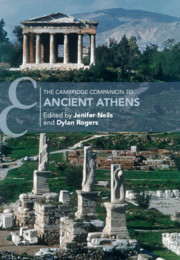Book contents
- The Cambridge Companion to Ancient Athens
- Cambridge Companions to the Ancient World
- The Cambridge Companion to Ancient Athens
- Copyright page
- Contents
- Contributors
- Abbreviations
- Athens: An Introduction
- 1 #Leagros: An Athenian Life
- Part I The Urban Fabric
- Part II Inhabitants
- Part III Business/Commerce
- Part IV Culture and Sport
- 21 The Philosophical Schools
- 22 Athletics, Democracy, and War
- 23 Theatrical Spaces
- 24 Athenian Festivals
- 25 Eating and Drinking
- 26 Sex and the City
- Part V Politics
- Reception
- Index
- References
25 - Eating and Drinking
from Part IV - Culture and Sport
Published online by Cambridge University Press: 10 March 2021
- The Cambridge Companion to Ancient Athens
- Cambridge Companions to the Ancient World
- The Cambridge Companion to Ancient Athens
- Copyright page
- Contents
- Contributors
- Abbreviations
- Athens: An Introduction
- 1 #Leagros: An Athenian Life
- Part I The Urban Fabric
- Part II Inhabitants
- Part III Business/Commerce
- Part IV Culture and Sport
- 21 The Philosophical Schools
- 22 Athletics, Democracy, and War
- 23 Theatrical Spaces
- 24 Athenian Festivals
- 25 Eating and Drinking
- 26 Sex and the City
- Part V Politics
- Reception
- Index
- References
Summary
The food and drink consumed by ancient Athenians and the setting and rules around its consumption reveal a great deal about their society. This study investigates both what they ate and how they ate it; the result provides a lens through which to view their social hierarchies and values.
- Type
- Chapter
- Information
- The Cambridge Companion to Ancient Athens , pp. 345 - 361Publisher: Cambridge University PressPrint publication year: 2021
References
Further Reading
To set ancient Athenian eating and drinking in a wider Mediterranean context, see Wilkins and Nadeau 2015. Dietler and Hayden 2001 provide theoretical background on communal feasting from a broad anthropological perspective. The seminal work on the ancient Greek symposion remains Murray 1990. Van den Eijnde et al. 2018 presents many facets of the history and impact of communal dining on the development of the polis in general. Glazebrook and Tsakirgis 2016 offers several case studies covering eating and drinking at Athenian taverns and brothels. The perceived relationship between ancient Greek diet and health is covered in Jouanna 2012, while Papathanasiou et al. 2015 provides an analysis of the physical evidence for nutrition in ancient Greece. Wilkins 2000 analyzes thoroughly the central role of food and eating as revealed in publicly performed comedies. Finally, Davidson 1998 explores how eating and drinking in combination with sexual behaviors are defining aspects of Athenian culture.
Bibliography
Additional resources to accompany this chapter can be found at: www.cambridge.org/NeilsRogers



